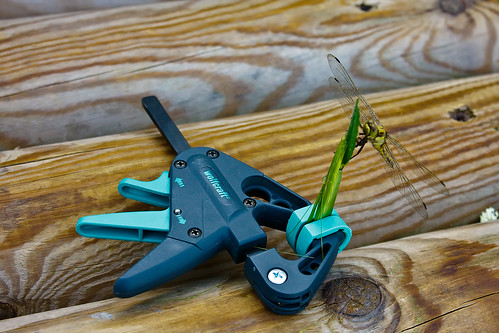
...to take this shot at 2.5x...

...and this shot at 5x.

I'm also carrying a small pair of scissors in my bag to cut grass stems. When I was finished I carried the dragonfly back to where I found it. Short tutorial here.
Moderators: rjlittlefield, ChrisR, Chris S., Pau



It's a single frame at F13 for the 2.5x shot, and F10 for the 5x image. I have yet to find a reason to focus stack -as long as I can take control of the motion in the scene then I won't lose detail to motion blur and I can stop the lens down. What a lot of people blame on diffraction is really motion blur due to a flash duration that's too long and too much motion in the scene. With the critter in the wood clamp, and with me bracing the camera either on my thigh or the park bench, it was easy to get a lot of detail.kwhunter wrote: I should have imagined that... It is not a single shot, is it? Too deep the FOV; how many stacked shots if I may ask?
What that causes Rik is a noticeable dividing line between the area that's sharp and the area that's out of focus and it looks very unnatural and it's one of the reasons why I don't stack -we just don't see that way. Even if you blend the exposures to try to hide the dividing line between the sharp and out of focus region it will still look odd. We also don't see everything in sharp focus, and getting a lot of detail (and along with it depth) in an image can be visually confusing -the eye doesn't know where to settle in the image.rjlittlefield wrote: ... If you open up and shoot this subject as a short stack, what comes out is not a picture that is sharper overall, but rather a picture that is sharper in selected regions and much less sharp everywhere else. It would be a very different image, and I think one that I would not be inclined to print big and stick on a wall.
I agree.Dalantech wrote:No problem Rik
In a large print both shots, at the distance that you'd view them, would look just fine.